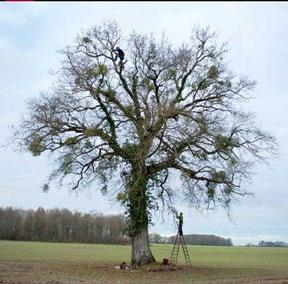
2 minute read
Mistletoe “Best Practices” Training
by Steven M. Johnson, DO
Mistletoe therapy came out of anthroposophic medicine through indications and research by Rudolf Steiner (1861-1925). It was never intended as an “alternative” therapy but rather a rational approach to cancer therapy heralding a new concept in therapy. Mistletoe has remained unique in its ability to both enhance immune properties in the body as well as affect the “soul” and physical symptoms important for quality of life in a positive way. Numerous studies have shown this to be true and now there are clinics and physicians using mistletoe therapy all over the world. In America, the landscape of mistletoe therapy is presently changing as organizations such as Believe Big have introduced this therapy to a wider circle of patients and clinicians. This has prompted the need for better education for practitioners.
There will be the first best practices “mistletoe training” course in Baltimore June 21, 2019. This is a special event with phase one of the nearbye John Hopkins School of Medicine Mistletoe Trial approaching completion. The course was originally going to be only 50 clinicians but opened to 70 due to very high demand. The course will also have a mentoring component which will take place over the following year. The course is approved by the Medical Section at the Goetheanum and is a special offering of Physicians Association for Anthroposophical Medicine (PAAM) educational efforts.
Mistletoe use has increased fourfold over the last two years, creating a demand for training and the need to expand a community of clinicians holding a high standard of practice. It is also important for Anthroposophic Medicine (AM) that training and standards keep a vibrant connection to the anthroposophical medical work as the prescribers of this important medicine expands beyond anthroposphic-trained physicians. It is also an opportunity to introduce AM to a new group clinicians.

This course is an attempt to bridge and discuss the role mistletoe has within both the academic and integrative circles of oncology practice. Both the participants and faculty represent academic, integrative, and anthroposphic practitioners. This is an exciting attempt to expand cooperation of Anthroposphic Medicine within a diverse group of practitioners. PAAM members have tried to be active within other organizations since the recent creation of our five-year development plan. This has taken us into relationships with the American Institute of Homeopathy as well as legislation to preserve homeopathic medicines, Academy for Integrative Health and Medicine and Health as well as the Academic Consortium for Integrative Medicine and Health. Others have been independently involved with Physicians for Informed Choice and their efforts. Faculty of the course include Dr. Marion Debus MD, Dr. Peter Hinderberger MD, Steven Johnson DO, Nasha Winters ND, and Paul Faust ND.
PAAM has also recently supported the translation of the anthroposphic oncology vademecum into English and is currently constructing a website project to support education and research about mistletoe. This will be located on PAAM’s newly revised and reconstructed international website anthromed-library ( https://www.anthromed.org/). We hope these efforts will support the healthy understanding of the potential for mistletoe use into the field of oncology.
Please look at what is going on in PAAM by visiting our new website at ( https://paam.wildapricot.org/). Take a look at our educational efforts and PAAM Friends initiative ( https://paam.wildapricot.org/Friends-of-PAAM). We appreciate your goodwill and support as we try to bring Anthroposphic Medicine to the next stage.
Dr. Steven Johnson is president of PAAM, the Physicians Association for Anthroposophic Medicine, and coordinator of the mistletoe training course.










